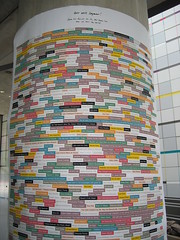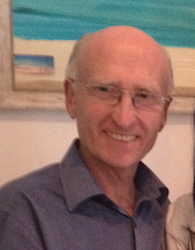By KENDRA LUECKERT
July 27, 2007 2:00 a.m. CST
Columbia- Columbia Public Schools’ newest elementary school will likely have classrooms clustered in pods off the center of the building. The concept is meant to foster more collaboration and interaction between students and teachers of the same grade level.
Among the committee’s design ideas were:
• A slanted roof that would blend in with the surrounding neighborhoods.
• Separate driveways for buses and cars, with each drop-off point leading into the same lobby area.
• The gymnasium, cafeteria and media center should be large enough that the community can use the areas as well.
• An abundance of natural light and bright colors.
“I think (bright color) just helps stimulate learning, and it’ll bring a lot of life to the environment, making learning more enjoyable for children,” Elaine Hassemer, principal of Paxton Keeley Elementary School, said after the meeting.
The story of Mabry Middle school and Dr Tim Tyson is a fascinating one. He spoke at the recent PLC07 conference in Boston MA and showed some of the short films his students made. Pupils were invited to make films when Dr Tyson saw just how powerful the use of new technology was in egaging young minds. He expected a few pupils to turn up to his first invitation but the room was filled by a much larger number of potential film makers.
Pupils were invited to make films when Dr Tyson saw just how powerful the use of new technology was in egaging young minds. He expected a few pupils to turn up to his first invitation but the room was filled by a much larger number of potential film makers.
The Maybry Film Festival is now an annual event and the films are quite amazing, limited to two minutes, the students have to focus on the message and the audience. They have to research and plan, master the digital media they are working with and work in teams. The results are truely amazing.
The idea is simple but the power of this as a learning experience is obvious.
The films for this year can be seen on the Mabry site here. Or click the picture to see the winning films.
The Building Learning Communities conference run by Alan November and the November Learning Team was my educational highlight of the year (probably the last few years).
Alan brought together a number of the best thinkers from around the world to share their thoughts with us on issues ranging from student voice, through school design to the best uses of educational technology.
It is the only conference I can remember were I actually cried twice (that is quite something for a bloke to admit but its true) The first tear jerker was the speech given by Tim Tyson from Maybry Middle school and the second was a session run by three students working with Marco Torres. These sessions changed my thinking and made me realise we still have a huge challenge ahead of us regarding the effectiveness of our education system and how best to make it relevent for all young people.
The conference was aso unusual in that there was a real sense of community - a clear sense of oneness with no boundaries between presentors and delegates. There are loads of photos of friends at BLC07 on Flickr (the one here was uploaded to Flickrby Edublogger on 19 Jul 07, 5.47AM PDT. edu.blogs.com/edublogs/blc07/index.html).
There is lots of information, presentations and podcasts avaiable on Alan's site.
You can create animated sequences and then post them to the Scratch online community to be dowloaded, modified and republished. I managed to produce a rather feeble attempt can be found here.
Since the launch of the Scratch online community in May 07 over 18000 animations have been posted to the scratch web site.
It is free and can be downloaded here.

Seymour Papert, developer of the Logo programming language, was hit by a motorcycle in Hanoi close to the hotel he was staying in.
The accident left Semour critically ill and he was tranferred to a hospital in Maine, USA. This image was taken at the MIT Media Lab during a visit during the BLC07 Conference last month.
The poster says 'Get Well Seymour' and the coloured stickers are names of individual colleagues at the Media Lab.
Sequence of images from The Met School in Providence, Rhode Island, USA
This album is powered by BubbleShare - Add to my blog
The MET School Providence, Rhode Island USA
The Met School is a very different school from those that many of us are used to. It began its work in 1996 as a new school aiming for a teacher pupil ratio of around 1 to 1. It aims to provide a very personalised curriculum with each student having an individual learning plan built as a result of detailed discussions between students and building learning programmes based on the interests of the students themselves. The school set out from the outset to create an environment which was based on small groupings of students where they are well known and their learning needs understood. The school currently has 750 students but these are distributed between three different school buildings each with its own principal and with learners between 14 and 18 years of age. The idea of the three building model being to create smaller schools within the overall campus. The school curriculum sets out to build the individual learning plan by discussing with students their needs and developing a work plan which the students put together themselves. Each student works with a member of the MET staff to plan and construct their learning plan and that person is responsible for making sure that the students get the support they need so that they can follow their individual programme. The key role of the advisor is not to teach the students (although they may actually do some teaching on specific subjects for those students that have certain requirements. Other teachers or experts are brought in to the school as required and the MET has links with specialists in various companies, colleges and the local University. The MET does not deliver set lessons on Maths or English etc, in fact there are not 'subjects' as such but does have five learning goals it uses as the basis for the curriculum.
These are:
- Quantitative Reasoning - How do I work things out? measuring and mathematics skills
- Social Reasoning - the views of others and how to work within teams. Examples from History.
- Empirical reasoning - How do I prove something? Analytical processes and scientific method
- Communications - How do I take in and express information? Literacy and languages, public speaking and information technology.
- Personal Qualities - What do I bring to this process? Time management, academic enquiry and empathy.
Each learning plan is constructed around these requirements linked to the specific interests of the student. As an example someone interested in music will develop a programme around their specific interests eg performance - aspects of mathematics, english and other subject elements will then be planned into the learning plan and then the students will agree the work they will do through a series of project proposals containing the detail of the programme based on the research they have done. The result is a learning programme which interests the students and yet meets the requirements of the school and those of the local US state. Our Form Periods in the UK are called an Advisory at the MET. It is the 'home-base' for groups of fifteen students lead by the adviser, who guides each student's learning throughout the four years of high school. Students at the school said that this meant that over the four years they got to know each other very well and as a result they develop a strong set of relationships and work as a team. Staff and students are all on first name terms and as far as the students all of the adults int he school are a resource to help them with their learning, including the office staff, cleaners, mentors. Other students are also regarded as an important source o support. Each student is assessed through a process known as Exhibitions. This is a process where students are required to present their learning to other students, their adviser and other advisory staff within the school. Each Exhibition is a one hour presentation by the student of their work and the process that have undertaken to complete it. The students said this was really challenging as other students knew when they were not performing as they should and this often resulted in additional work being done to ensure that they caught up with what was required. All of the students we met said that they really felt that they were understood by their advisors and that they were part of a team. They loved going to the school and that the work they did was the best they could produce - not only because the school demanded it but they were working on what they were interested in and what would be of use to them in the future. Further information about The MET School can be found here. Particularly interesting information about The MET can be found under 'The Education' heading as that explains the way in which the school sets out to support their students.
An interesting video with the sorts of views expressed by students we would all like to hear. Some say the curriculum is rather traditional.
Youtube movie
The online application is free to use for a limited number of diagrams but for most casual users this would be ok.
There are a number of different shape libraries including flowchart sybmols, room layouts and computer interface design. Users can make their own as well.
Once created the drawing can be shared with other collaborators or published to a Blog or Web site using a simple script. Fles can also be saved for off line use as jpg, svg or png files.
Access Gliffy at http://www.gliffy.com/










